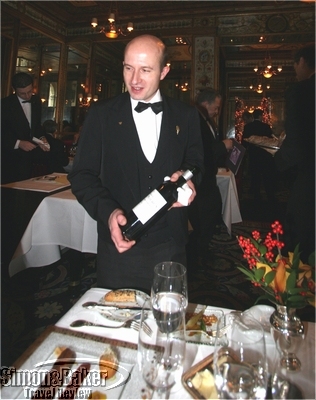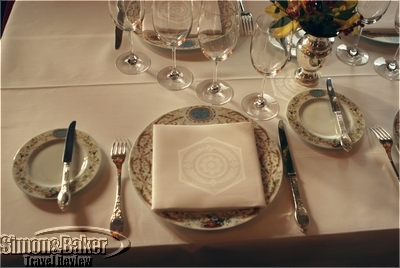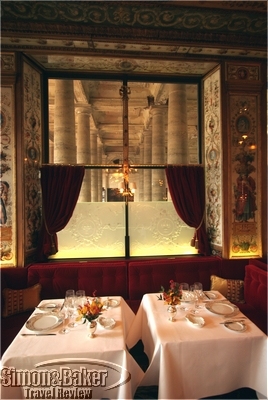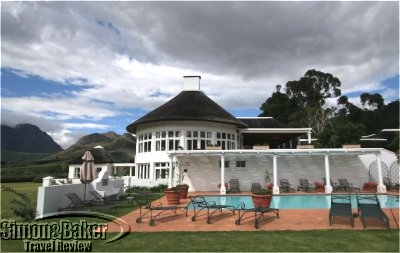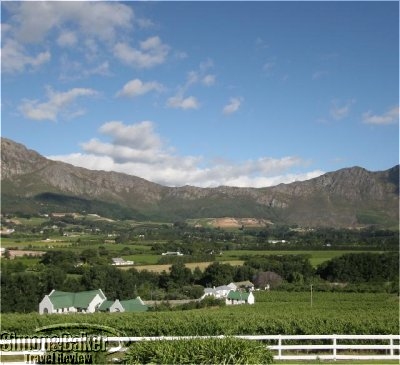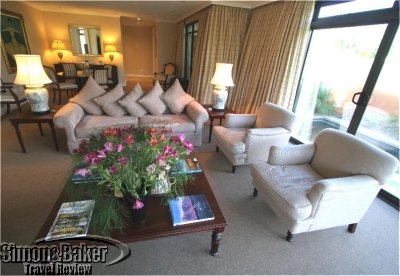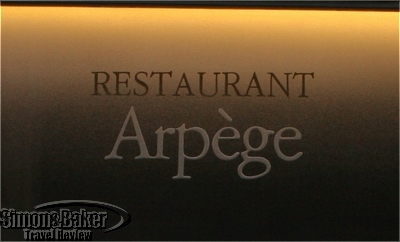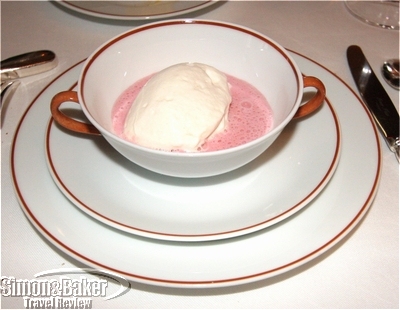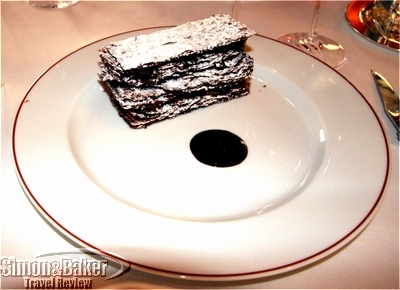by Editor | Apr 7, 2008 | Audio, Restaurants and Food
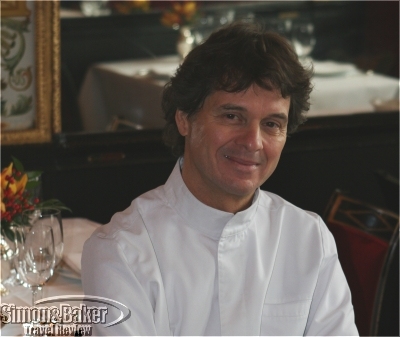
Guy Martin, executive chef, Le Grand Vefour
Join us in our inaugural podcast program with an interview, in French (see written English translation below), with Guy Martin, famous executive chef of Le Grand Vefour.
He recently discussed his restaurant, one of the most popular gourmet French restaurants in the world, and other culinary projects with Elena del Valle, MBA host of the new Simon & Baker Travel Review Podcast program. In addition to running one of the most celebrated restaurants in Paris, he’s in charge of the Air France First Class dining service and a second more informal restaurant in the City of Lights.
To listen to the interview, click on the play button below
Translation
EDV: You became the president
GM: I was already… I was at the Chateau de Divonne; I managed the Relais Chateau de Divonne for eight years I managed the Relais Chateau de Divonne when Jean Taittinger ask me to come in November 1991 he named me manager of Le Grand Vefour and administrator of Le Grand Vefour and the following year he named me president of Le Grand Vefour.
EDV: You decided to take all that. It’s a lot of work.
GM: It’s a lot of work you know but before I managed a castle with 70 employees and 30 rooms with a park of 20 hectares so it was big and I found that it was better to oversee everything because then I can select the staff and supervise the teams. It’s a greater freedom. It’s what I wanted.
EDV: What do you think after all these years about the castle, the restaurant, life…
GM: It’s two different lives… for me because I’m from the country. Life if the country has a slower pace. We are… things move much more slowly so you are much closer and in greater contact with nature. I was active in sports. I’m from the Savoy so I facing my mountains the Mont Blanc. At the same time there is less activity and it’s less regular than in Paris. And in Paris you have regularity. The important thing is that what you offer that the cuisine be in harmony with the client’s expectations. If you are in harmony with the client’s expectations, if the setting if everything goes well you are full every day and being full every day allows you to have a certain number of personnel, to have the best ingredients, the best products, to select the best growers and producers to have a true regularity in your work which is very important which is very very important.
EDV: Is it hard?
GM: Is it hard? To be in harmony with your clients is to listen to them, is to know to listen to them, it’s to understand their expectations, what does the client expect today, what do we have to provide to… it’s just to know … if you will for the client what’s really important I think is to be attentive to their expectations. What does he want, what does he desire. First of all it’s to listen and try to offer them perhaps to travel roads they don’t know. That they haven’t thought of going to. In a world in life in a context that isn’t always reassuring you must first reassure the client. So reassure the client, serve the best products with great ability my beef, my carrots, my leeks, the caviar where does it come from? Are we able to reach to the producer, to the sturgeon? And, I promise you we are able to reach to the sturgeon of the caviar we have, to know which cow, etc. Where did she grow up, in what way, what was the nutritional charge? So it’s to reassure the client and it’s also to take the client on a trip. To take the client on a trip through the presentation, the spices, in relation to what you bring in a personal way so that a recipe develops into a moment of seduction in the end.
EDV: It’s a métier, an art. It’s not just a job…
GM: You know I think I cook like the mothers who don’t work or who have the time to prepare a dish on the weekend every once in a while a dish for their children or their husband or for someone they care about. It’s a true cuisine of the heart. And I’m lucky to be in a métier that is like that for me every day.
EDV: And people, do they appreciate it?
GM: I think people appreciate it because we are full, we are lucky to have three Michelin stars, to place well with the guides, to have good press. People appreciate it but nothing is guaranteed. We have to ask ourselves daily and never think that we are the best, never think we are unique and I realize that.
EDV: What do you do to maintain your place? Do you constantly change the menu? How do you decide what to keep and what to change?
GM: The most difficult thing is to figure what dishes to keep or not to keep from the menu because we have to always think of the client and at the same time we have to enjoy cooking. And we live the menus to the rhythm of the seasons so there are four menus per year plus the market suggestions. So now for example we have the first truffles that arrived in the market, fabulous sea urchins… In the market for game meats there is hare and soon there won’t be any more French hare available this means we have to work with what the producers and suppliers have or if my fish seller tells me he has an extraordinary fish we will add it to our suggestions.
EDV: Do you have a meeting once a week, once a month? How do you decide on the menu?
GM: I test recipes and I have senior staff, whether its Luc Bechet and Pascal Pugeault, sample them. We taste them together; we critique them together but there isn’t really a formal meeting. The meeting is really every day for each meal because every day at lunch and dinner I’m in the kitchen.
EDV: You’re the executive chef. Often we think you don’t cook often; that you visit but that you’re not there every day.
GM: I’m here and of course I have colleagues who are very capable but I’m still very much here.
EDV: Always with your hands in the kitchen.
GM: Yes, because it’s my métier. It’s what I love. It’s here where I fell good.
EDV: At the same time, you find the time to do other things. Are you still with Air France?
GM: With Air France I do first class worldwide. It’s team that has been leased by Air France for our gray matter I would say. We develop the recipes in Paris and then I have a team that travels and oversees on site and travels around the world. So there’s Air France; there’s Monoprix where we develop a line… it’s the same there’s another team. I … the days are long and … I think when you have a good team, when you know how to delegate, when you surround yourself with the best. Everything I do has a human touch.
EDV: So there’s a space for everything.
GM: Yes, everything in its place and for leisure as well.
EDV: Is there time for that as well?
GM: Absolutely.
EDV: How would you describe the culinary style of Le Grand Vefour and yours personally?
GM: It’s always difficult to talk about your own cooking but I would say it’s modern, contemporary with the best ingredients we can find in the markets with the producers that make our products; we have the same way of thinking about details and ethics. I’d say it’s a cheerful cuisine, a healthy cuisine. I hope it makes clients travel, reassures them and gives them pleasure and makes them want to smile.
EDV: You have people who live in France, you obviously have tourists because you are known around the world is it difficult to introduce them to this well known cuisine and at the same time find a balance?
GM: I understand. I think that today people travel more and more and that Americans, Japanese, the Chinese to talk about the countries the furthest away without discussing Europe eat better every where and that people travel. People travel and it’s like on TV, zap, at noon they’re here at night they’re there. They really have a point of reference and these references make the level of cuisine go up because when you have points of references you have demands and these demands make it necessary for every one to be motivated, not fall asleep. You know that at the beginning you have good products. It was Brillat Savarin who said that with very good products you can only have good cuisine. Other than to skip a dish, we start with excellent products and of course there are choices that may be more difficult for certain clients; but to listen to clients to know what he likes that’s the role of the maitre d’hotel; understand if the client wants a slightly more classic dish or something much more modern or does he want … does he want to be surprised, does he want to be reassured, does he want both? That’s the job of the maitre d’hotel to understand the wishes of the client.
EDV: Is it easy with the tourists, for example? When you have people who come from different countries who want something different that the people who live here who can come whenever they want?
GM: Not really with foreigners because outside of Paris. We have clients from the countryside who come to Paris every once in a while. To come to the Grand Vefour could be an event for them, the event perhaps of that year. No, there’s really no conflict there’s really no problem it’s just not to confuse and that’s truly the role of the maitre d’hotel when the client asks a question to answer the good questions the client asks. And if by chance the client didn’t like something, it’s the role of the maitre d’hotel to see if the dish was incomplete, if the client was dissatisfied and in that case definitely change the dish, definitely offer him the opportunity to taste something else; so the role of the maitre d’hotel is very important.
EDV: The team. Tell me is it important? What’s the role of your team?
GM: Without the team there is no cuisine. Without the team there is no cuisine because the cooks team, to talk about that, because the chef can’t prepare meals for 50 people where everything is ordered a la carte, where sauces are made to order, where vegetables are made to order; that means to maintain a structure with it we have 22 cooks who assist me, who follow my lead; and the overall team takes care of everything from the beginning including the valet driver who parks your car, the person at reception who takes your coat; it’s the maitre d’hotel who will accompany to your table, who will take your order; it’s the wine steward who’s going to come to suggest a wine. It’s a grouping that you would have a hard time viewing separately because if you have sumptuous cuisine but then you have a décor that’s not pleasant, that’s not professionals but especially that’s not pleasant, because in the end you have a team that’s a bit less professional but be served by smiling, cordial people it’s okay but … imagine if once you’re seated you feel that you are bothering the staff you will feel apprehensive about tasting the dishes and obviously that will not be good.
EDV: That colors the meal.
GM: Yes, that’s why it’s important and we often have meetings with the first maitre d’hotel to make sure it’s truly animated and there’s a warm ambiance. I’m not a server so I speak with much hesitation but the critics say we offer some of the best service in Paris. I’m not a server so … the clients say, French clients and foreign clients, the clients say that we offer some of the best service in Paris, service that is very client oriented, very friendly, very professional. It’s all important.
EDV: What can we expect? Do you have recipes that are coming? What do you think about when we talk about the future of Le Grand Vefour?
GM: The future of Le Grand Vefour? 1860 establishment of Le Grand Vefour, 2000 more a century later it’s still here, and in a century it will still be here me, I will no longer be here that means it will continue through the years without any problems, that it will remain a joyous, a screen, something unique in the world with its original décor, etc; it’s a historic monument and we, on a small personal perspective, the next menu will be the nicest one; I will publish a book and will continue writing and try to continue to host children as I do to host children here on a regular basis to introduce them to the palate.
EDV: Oh, you have meals for children?
GM: I host schools on a charitable basis. We spend a morning with them; I have them taste a dish. It’s to continue with this métier with love. One day it will be more sacred. I tried not to fight it too much. You must stop at the right time.
EDV: We’ve noticed over the last years that, for example, you speak a little more English, it’s a bit more open to tourists, in a good way I mean so we noticed some things that have changed do you anticipate additional changes?
GM: Our foreign clients, we have a lovely following in Europe with increasing Spanish and Portugues clients. Our English clientele has increased significantly, especially following the Routard. We have regular clients who come, for example, Friday for lunch who make the roundtrip just for to eat. A superb clientele. A superb English clientele. The Routard, I say, thanks to the Routard we have several tables per meal per week that come. It’s really been very noticeable. The Belgian clientele is always visible. We have an increasing number of German clients; we have had lovely write ups in Germany in pretty magazines and very good reviews in Germany so we have a large German clientele. That’s to say the Belgian clients who are represented, the European clients. We have many Italians during the holidays when they are on vacation. And the Swiss on a regular basis. In terms of clients outside the EU, American clients are always visible in spite of the slightly weak dollar for us they are always present. There are many Americans who own apartments in Paris. We have a large clientele from California and New York who travel always. We have a large Brazilian clientele.
EDV: Yes?
GM: We have a lovely Brazilian clientele. China, there are more and more Chinese… more and more Chinese. We have a loyal Japanese clientele because for many years I’ve traveled to Japan; it’s a country I love that their cuisine. That cuisine that I offer corresponds well with their tastes. We have a loyal Japanese clientele. Some Russians. In general, this is the core of our clientele.
EDV: You just opened with your former top staff member a new restaurant. What would you like to tell us?
GM: I’d like to tell you it’s a restaurant called Sensing for the senses. That’s to say that all the senses are open and for me it’s a way to blend the work with a décor I love done Jerome Fallon Dumas. I feel well in the setting with pure lines, very pure, very light and at the same time everything that’s in the restaurant was designed. There is that was nothing purchased from a catalog. All the stools, the chairs, the tables, everything was made with the best materials… there was an almost artistic research on the movement, the bar. It’s the largest bar in albar in the world. It’s seven meters etcetera… with gold cover; the ironwork for the staircase was made my small artisans; it’s really the work that’s Art Deco that’s … like an apartment, like a luxury apartment where someone lives; and the cuisine we developed it together with Remi Van Peteghen and he’s the one who with his excellent team with the manager whose name is Franc Carabogosian who is also a former of Le Grand Vefour also and who manages the restaurant with absolute freedom.
EDV: And you?
GM: Me, I sometimes go for dinner. . . I trust them because when I have a relationship I can’t work when someone oversees me too closely so I trust them. I trust them. They can buy the best products; some of our suppliers are the same and that works well. For the first year that it’s working well, that they are developing well and maybe they will open in the spring in Boston.
EDV: Oh really?
GM: Yes
EDV: In terms of the meal, who will like it?
GM: We have a great Parisian clientele and Jerome has a similar clientele as Le Grand Vefour, an international clientele. We have a great Parisian clientele and a large international clientele also because there are three separate dining rooms with their own décor with gallery quality Baccarat on exhibit. There are three separate dining rooms with their own décor. Sometimes clients prefer the third, the second or the first setting so there’s plenty to keep clients satisfied in terms of decoration and the cuisine is diverse, it’s light, it’s technical without being annoying. It’s a cuisine I adore.
EDV: It’s not the same style you have at Le Grand Vefour?
GM: Totally different
EDV: That would be more like, help us…
GM: The style of Sensing I would say, well for starters there are no ties; shirts are open. All the staff has been part of luxury gastronomy so they know what it is to offer luxury but at the same time it’s much more relaxed.
EDV: And the food?
GM: In terms of the ingredients, we’ll say they are the same suppliers. Perhaps instead of using turbot we’ll use a fish I don’t know that is less expensive; we’ll use sardines; we’ll use sole; instead of using a prime cut of beef we can use a less expensive cut. See they are the same suppliers. The bread is the same bread as here, the butter. The suppliers, most of the suppliers, are the same as here.
EDV: So it’s perhaps a part of the same clientele you have here but one day they feel like dining in a more relaxed setting.
GM: More relaxed and it’s another ambiance. There’s less staff, it’s not this décor…
EDV: Do you know, how many team members do you have here?
GM: Here we have 40 people for 50 clients.
EDV: So it’s true luxury in terms of the meal, the service…
GM: One person per client. The number of staff per client.
EDV: Is there something I haven’t asked you that you would like to share with your admirers?
GM: To believe in your dreams and that everything is possible in life. You just have to love and have the desire to do it.
EDV: Thank you.
GM: It’s me who thanks you.
by Editor | Mar 3, 2008 | Restaurants and Food
Photos and article by Josette King, in cooperation with Lee Fuller, oenophile and wine collector
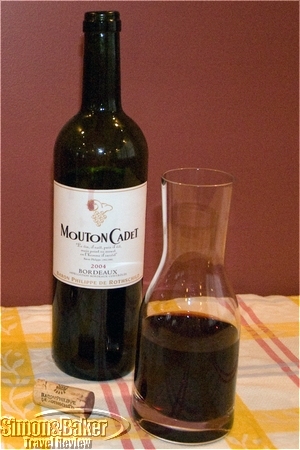
Baron Philippe de Rothschild, Mouton Cadet, Bordeaux 2004
A few years ago, as we were planning our family Thanksgiving dinner, my wine enthusiast son Lee Fuller declared himself unwilling to serve the usual obvious whites with the traditional turkey. He volunteered to lead the reform by arranging a tasting, a few days prior to the gathering, of five moderately priced wines to vie for an appearance on our holiday table. During the event, we first tasted (and expectorated) each wine on its own and later sampled each one in turn with tiny portions of food. A lively evening of discussion followed and a holiday tradition was born!
Our most recent tasting took place a few days before Christmas. I was entrusted with the choice of wines. Mine was an impulsive selection of French wines, guided more by memories of my Paris youth than considerations of what would best compliment our Christmas Eve raclette or the roasted leg of lamb and Bûche de Noël on our Christmas Day menu.
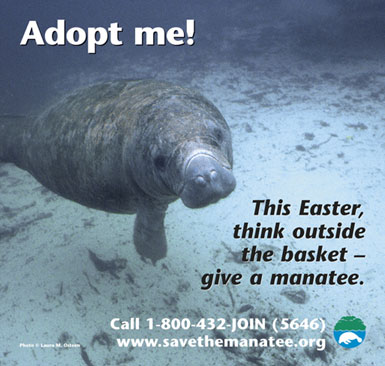
I adhered to our basic tenet: five wines, moderately priced (under $25). I chose one sparkling wine, one white, two reds and a sweet red dessert wine: Lucien Albrecht Crémant d’Alsace Brut Rosé, Domaine Fournier Sancerre Sauvignon Blanc 2005, Marc Kreydenweiss Domaine des Perrières Costières de Nîmes 2003, Baron Philippe de Rothschild Mouton Cadet 2004, and M. Chapoutier Banyuls Grenache Noir 2004. Here are our findings:
Lucien Albrecht, Crémant d’Alsace Brut Rosé (sparkling – non-vintage)
Approximate retail price: $19.99
Since we especially enjoy brut sparkling wines as an aperitif, we started with a Crémant d’Alsace Brut Rosé, non-vintage, from Lucien Albrecht (crémant is the official appellation that designates French sparkling wines produced outside the Champagne region). With its tiny bubbles and lovely peach color, this luscious sparkler looked and tasted much more expensive that it actually was!
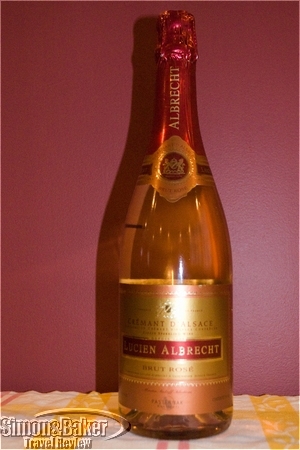
Lucien Albrecht, Crémant d’Alsace Brut Rosé
Made from 100 percent pinot noir, its aroma was dominated by red berries with a hint of rose petal. On the palate, it generously released raspberry, strawberry and red currant flavors. We unanimously loved this crisp and elegant wine as a starter to our evening, alone and with light hors d’oeuvres. One minor caveat: we tried it again at the end of the evening and found that it didn’t stand up well to our chocolate dessert.
Domaine Fournier, Sancerre, Sauvignon Blanc 2005
Approximate retail price: $19.99
I have always been fond of Loire Valley whites, especially Sancerre. Therefore, this was an easy selection, since Domaine Fournier is known as one of the most important estates in the Sancerre region. Made of 100 percent sauvignon blanc grapes, this lively, pale 2005 Sancerre opened with a pleasant citrus aroma that developed on the palate as a lemon and grapefruit taste with undertones of green apple. Its dry, clean finish lingered nicely.
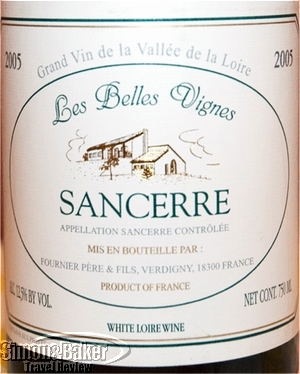
Domaine Fournier, Sancerre, Sauvignon Blanc 2005
We unanimously declared it an excellent aperitif candidate. We also enjoyed it with fresh goat cheese, and with seafood. Later that week, we found it went well with pasta in a cream and herb sauce. This is another refreshing, fruity wine that I will definitely enjoy serving throughout the year!
Marc Kreydenweiss, Domaine des Perrières, Costières de Nîmes 2003
Approximate retail price: $13
I was intrigued by this wine because of its biodynamic status. Biodynamism is a combination of organic winemaking and sustainable agriculture that adopts the use of organic fertilizers, the elimination of chemical pesticides and herbicides, and other health-conscious practices for the protection of the ecosystem. In Alsace, the Kreydenweiss estate has been in existence for over three and a half centuries. The current owner Marc Kreydenwiess completed the conversion of the entire estate to biodynamic culture in 1990. He applied the same principles to his Domaine des Perrières as soon as he purchased it in 1999.
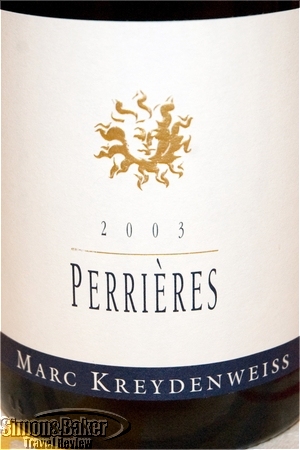
Marc Kreydenweiss, Domaine des Perrières, Costières de Nîmes 2003
The 2003 Perrières we sampled was an earthy red Rhone blend of cardigan, grenache and syrah, deep ruby in color, with an aroma of red fruit, spices and a hint of oak. The palate was a bit tart for a red, spicy and somewhat tannic. I detected a touch of licorice in the finish, an issue for me as I dislike that taste. However, Lee our experienced oenophile immediately identified the mellow presence of grenache and a hint of vanilla. He declared the 2003 Costières de Nîmes, Domaine des Perrières a good candidate for summer drinking on its own, with cob salad or grilled meat. N.B.: We decanted this red 30 minutes before tasting.
Baron Philippe de Rothschild, Mouton Cadet, Bordeaux 2004
Approximate retail price: $8.99
In my younger decades, the Rothschild Mouton Cadet was my reliable red stock Bordeaux. This broad distribution wine from France had the advantage of being always available, of predictable quality and affordable. I couldn’t remember when I drank it last, so I decided to give it another try. As we uncorked it I detected a faint musty smell to it. However, after we decanted it for 30 minutes it opened up to reveal a pleasing earthiness and a flavor of dark berries with notes of cassis. This blend of 65 percent merlot, 20 percent cabernet sauvignon and 15 percent cabernet franc was deep red in color, with just enough authority that we knew we were drinking red wine. Yet it was simple enough that it transferred well between different appetizers. It also worked successfully with a cheese tray but did not hold up to red meat. We will keep in mind for large casual gatherings.
M. Chapoutier, Banyuls, Grenache Noir 2004
Approximate retail price: $25 for a 50cl bottle.
To me, Banyuls will forever evoke childhood memories of a small vacation town on the western Mediterranean coast, where France touches Spain, with the foothills of the Pyrenees as a backdrop; and the rich, sweet, dark wine of the same name. I remembered it as a Port-like nectar ubiquitously served as an aperitif and dessert wine.
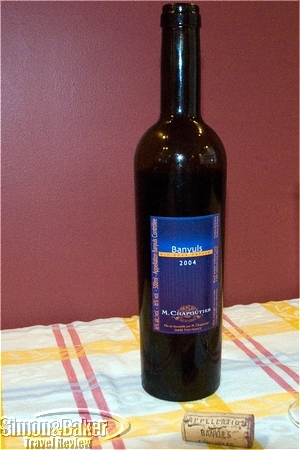
M. Chapoutier, Banyuls, Grenache Noir 2004
We tasted the Chapoutier Banyuls Grenache Noir 2004 at dessert time. Made of 100 percent grenache noir, it was deep garnet in color, with aromas of dried fruit and candied citrus. The palate was creamy and sweet, with rich undertones of cherries and chocolate. We enjoyed it on successive occasions with Roquefort cheese and chocolate desserts, as well as on its own for after-dinner sipping.
While our original tasting intent was to focus on wines for our holiday table, we are delighted to have discovered an assortment of wines we will enjoy on multiple occasions throughout the year.
by Editor | Dec 10, 2007 | Restaurants and Food
Article by Elena del Valle and photos by Gary Cox
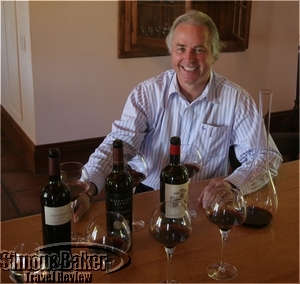
Kevin Arnold at The Jem tasting
For years South African wine makers have been making inroads into the world wine markets. Slowly their wines have gained favor among wine lovers around the globe. In the last 20 plus years the production volume and number of vintners has increased manifold. For example, in 1979 there were 24 wineries in Stellenbosch and now there are 187.
At the same time, quality wines have been making appearances in the domestic market and abroad with increasing frequency. This is due in part to South Africa’s high percentage of small producers who have to excel in their work to survive in a highly competitive world wine industry.
A prime example of this is Kevin Arnold of the Waterford Estate in Stellenbosch in the Cape Wineland area near Cape Town. After years of producing wines he realized that to make his mark in the world he needed something special. In 2001, he planted 11 varieties of grapes in the hope of finding the perfect blend. He waited patiently and eventually discovered that a combination of eight of the original 11 resulted in the type of wine he sought. The Jem, named for his business partner Jeremy Ord, was launched initially in South Africa and Sweden in November 2007. It will be available in London in January 2008 and in New York in February 2008.
During a recent visit to South Africa, we met the well known vintner and were among the first to taste The Jem 2004, the first wine released from the blend. It is new yet well set in a familiar European base. What makes it unique is precisely that combination of tradition and novelty. French Bordeaux and South African flavors join to form a rich and smooth wine with a memorable finish.
Arnold knew he was on the right path when the wine continued to reach spicy aromas and flavor. “That is the ultimate test. That is the hallmark of a great wine,” said Arnold. “I want to be known as South Africa’s premier red wine producer. I think you need to enjoy what you do and I certainly do; and seeing our wine served at top restaurants is a boost.”
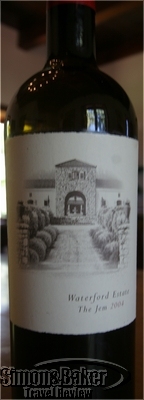
The Jem 2004
The Jem is made with Cabernet Sauvignon (35%), Cabernet Franc (24.5%), Shiraz (15%), and (Mourvèdre 10.5%), as well as Petit Verdot, Malbec, Merlot and Barbera. The fermentation process took place over 19 months in a combination of 40 percent first fill French oak with the remainder second fill in French barrels. It is due to mature between 2010 and 2018.
In addition to taking a bold innovative step by creating a new blend Arnold is trailblazing by establishing a quality price point of R680 surpassing the $100 mark. Last we heard sales of The Jem were brisk at the winery for the limited production wine. We suspect that as the word spreads among Waterford enthusiasts and the wine is released in early 2008 in the United Kingdom and United States, two of the winery’s top three export markets, the remaining bottles will disappear before much longer.
Arnold who has been in the wine business for more than 30 years wants to make a statement to the world with his wine. He wants everyone to know South Africa occupies a distinctive and worthy place in the wine firmament. When he was testing the wine he was thrilled to discover it had staying power. He hopes The Jem will mark a significant milestone in his quest for distinction.
Arnold’s winery is certainly on the right path. The Waterford Estate produces a limited quantity of wines and specializes in reds. The winery only uses its own grapes and 20 percent of all sales take place at the award winning cellar door. We visited the estate recently and enjoyed Waterford’s chocolate wine tasting. Click here to read about the estate and chocolate wine tasting.
